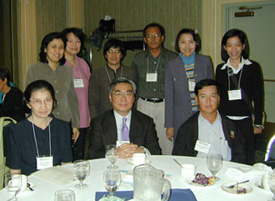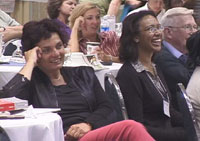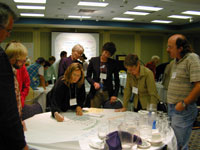The IIRP's fifth international conference, "Building a Global Alliance for Restorative Practices and Family Empowerment, Part 2," in Vancouver, British Columbia, Canada, was a tremendous success, thanks to the many dedicated participants who journeyed from far and wide to contribute their wisdom and experience to the event. A delegation from the Thailand Ministry of Justice, including Kittapong Kittayarak, director general of the Department of Probation (seated middle), and Wanchai Roujanavong, director general of the Department of Juvenile Observation and Protection (seated right)
A delegation from the Thailand Ministry of Justice, including Kittapong Kittayarak, director general of the Department of Probation (seated middle), and Wanchai Roujanavong, director general of the Department of Juvenile Observation and Protection (seated right)
Attendees came from such countries as Australia, Belgium, China, England, Hungary, Ireland, Japan, the Netherlands, Scotland, South Africa, Spain, Sweden, Thailand; seven provinces and two territories of Canada; and 26 states and the District of Columbia in the United States. There were representatives of such First Nations and Native American nations as the Akwesasne, Aleut, Champagne and Aishihik, Couchiching, Flying Dust, Heiltsuk, Inuvik, Kahnawake, Liard, Mi'kmaw, Ojibway, Peguis and Wet'suwet'en.
It was exciting to see how restorative practices are gaining ground across the world, in criminal justice, school, child and family welfare, and other applications. It was also encouraging to note that restorative initiatives are beginning to encompass entire communities, instead of being limited to separate venues.
Plenary sessions
The conference locale, British Columbia, is an area where restorative practices are flourishing. Two plenary sessions highlighted this rich activity:
 Bonnie George, of the Wet’suwet’en First Nation, in the northwest part of British Columbia, discussed the Wet’suwet’en Unlocking Aboriginal Justice Program (WUAJ). The WUAJ is a community-driven restorative justice project developed in response to her people’s dissatisfaction with the Canadian judicial system and the disproportionate number of Aboriginal people involved in the federal and provincial court systems. WUAJ’s focus is on restoring balance and harmony within the community. Related paper here.
Bonnie George, of the Wet’suwet’en First Nation, in the northwest part of British Columbia, discussed the Wet’suwet’en Unlocking Aboriginal Justice Program (WUAJ). The WUAJ is a community-driven restorative justice project developed in response to her people’s dissatisfaction with the Canadian judicial system and the disproportionate number of Aboriginal people involved in the federal and provincial court systems. WUAJ’s focus is on restoring balance and harmony within the community. Related paper here.

 Rick Hugh and Jenni Lynnea, educators in Surrey, Greater Vancouver, discussed the challenges of implementing restorative practices in their school district, one of the fastest growing and most broadly multicultural districts in Canada. Two busy secondary educators, Hugh and Lynnea embarked on a mission to educate others about the potential for restorative practices in their school district. Their efforts have provided the foundation for a respectful environment for the district's staff, students and families, while building community.
Rick Hugh and Jenni Lynnea, educators in Surrey, Greater Vancouver, discussed the challenges of implementing restorative practices in their school district, one of the fastest growing and most broadly multicultural districts in Canada. Two busy secondary educators, Hugh and Lynnea embarked on a mission to educate others about the potential for restorative practices in their school district. Their efforts have provided the foundation for a respectful environment for the district's staff, students and families, while building community.
Numerous breakout sessions on restorative practices in British Columbia included an overview of the Royal Canadian Mounted Police (RCMP) restorative justice programs, reported by RCMP Corporal Jim Cooley, and a group presentation on the partnership of interconnected restorative community justice programs in Nanaimo, Vancouver Island, involving schools, police, youth court and retail loss-prevention initiatives.
Use of community justice forums is on the rise across British Columbia. In this voluntary process, a victim, an offender and their supporters come together with a facilitator to restore relationships and repair harm caused by an incident.
Expanding the focus outward from British Columbia, two plenary sessions showcased the international scope of restorative practices:

 Mija Bergman and Annelie Edren, of the Stockholm City Mission in Sweden, talked about implementing restorative practices with homeless men and women. In the City Mission's day centers and shelters, both formal and informal restorative practices are proving highly effective with clients who are drug or alcohol dependent or severely mentally ill. Related paper here.
Mija Bergman and Annelie Edren, of the Stockholm City Mission in Sweden, talked about implementing restorative practices with homeless men and women. In the City Mission's day centers and shelters, both formal and informal restorative practices are proving highly effective with clients who are drug or alcohol dependent or severely mentally ill. Related paper here.
 Rob van Pagée, of Eigen Kracht Centrale and Op Kleine Schaal, in the Netherlands, discussed the implementation of the Real Justice and family group conferencing models in his country and beyond. He advocated the regular use of restorative practices, not only because he believes that the best solution is for the family and their social network to come together in a circle to solve their problems, before professionals intervene, but also because it will give insight into possibilities for a new relationship between government and citizens. Related paper here.
Rob van Pagée, of Eigen Kracht Centrale and Op Kleine Schaal, in the Netherlands, discussed the implementation of the Real Justice and family group conferencing models in his country and beyond. He advocated the regular use of restorative practices, not only because he believes that the best solution is for the family and their social network to come together in a circle to solve their problems, before professionals intervene, but also because it will give insight into possibilities for a new relationship between government and citizens. Related paper here.
Two staff members from the IIRP, the conference host, which is based in Bethlehem, Pennsylvania, USA, presented plenary speeches, as well:
 Paul McCold, IIRP director of research, discussed three conceptual structures: the social discipline window, stakeholder roles and the restorative practices typology, which together explain the "how, what and who of restorative justice theory." Related paper here.
Paul McCold, IIRP director of research, discussed three conceptual structures: the social discipline window, stakeholder roles and the restorative practices typology, which together explain the "how, what and who of restorative justice theory." Related paper here.
 Ted Wachtel, IIRP president and founder, talked about how restorative justice principles have extended into areas beyond criminal justice and explained the conceptual foundations of restorative practices,including the psychology of affect, the compass of shame and fair process. Related paper here.
Ted Wachtel, IIRP president and founder, talked about how restorative justice principles have extended into areas beyond criminal justice and explained the conceptual foundations of restorative practices,including the psychology of affect, the compass of shame and fair process. Related paper here.
 Laughter during a conference plenary session speechNumerous fascinating breakout sessions were offered to (and by) conference participants from all over the world. It was difficult to choose which ones to attend, as is always the case at IIRP conferences. Here is a brief random sampling:
Laughter during a conference plenary session speechNumerous fascinating breakout sessions were offered to (and by) conference participants from all over the world. It was difficult to choose which ones to attend, as is always the case at IIRP conferences. Here is a brief random sampling:
- Kittapong Kittayarak, director general of the Department of Probation, and Wanchai Roujanavong, director general of the Department of Juvenile Observation and Protection, Ministry of Justice Thailand, discussed the revival of the concept of restorative justice in their nation’s criminal justice system.
- Donnie Martin and Patrine Baptist, of the Youth Court of South Australia, discussed how children and young people can be a part of the decision-making process in cases of abuse or neglect, through family group conferencing.
- Bruce Schenk, Michael Maguire and Ron Cameron, of Brookside Youth Centre in Cobourg, Ontario, Canada, talked about restorative conferencing with clients and staff at a secure youth facility.
- Louise Thompson and Rena Smoke, justice workers with the Mohawk Nation of Akwesasne, which spans the border of Canada and the United States, presented on the Neh Kanikonriio (Good Mind) Council community justice program.
- Bill Whyte, director of the Criminal Justice Social Work Development Centre of Scotland, spoke on the use of restorative practices within the youth justice system in his country.
- Constance Fenton, a social worker and Real Justice conferencing trainer in the Guilderland Central School District, in New York, USA, talked about using restorative practices proactively in schools.
- Molly Baldwin, executive director of Roca, Inc., reported on the use of restorative circles with gang conflicts in Massachusetts, USA.
- Joanna Mears, a police constable and manager of a new restorative conferencing pilot for adult criminal cases in Thames Valley, England, spoke about this project.
- Julia Fassina, a former police officer, now project officer for the Drug Education Network, Inc., discussed a restorative school-and-community program in Tasmania, Australia.
- Philip Kader, a probation officer in Fresno, California, USA, talked about the systemic change from retributive to restorative justice in his county.
 Conference participants work on their group “map,” during the special interactive plenary session, “Mapping the Restorative Universe.”
Conference participants work on their group “map,” during the special interactive plenary session, “Mapping the Restorative Universe.”
At IIRP conferences every year, participants network and share their experiences informally, thereby contributing to the growing global alliance for restorative practices and family empowerment. At this year's conference, a special interactive plenary session, “Mapping the Restorative Universe,” facilitated by restorative justice practitioners Thom Allena and Mark Seidler, provided a more formal structure to nourish these important connections.
Conference attendees convened in self-chosen groups to discuss themes such as funding, role of the facilitator, child and family welfare, prisons, victim awareness, and homeless people and restorative practices. The aim was for attendees to see how their work fits with and contributes to restorative initiatives around the world. Participants discussed their experiences and opinions relating to each topic. Then each group created a graphic representation or "map" of their discussions.

Related paper here.
Breakout sessions
(Papers voluntarily provided by presenters. These do not represent all breakout sessions)
Reno Guimond, Restorative Justice and Healing in a Federal Prison for Women
Doug Hillian, Court-Ordered Conferencing in British Columbia
Phil Kader, Systematic Change: The Fresno Model
Michael Kearns, Introducing Restorative Practices in the UK Justice System for Youth Crime
Kittipong Kittayarak, Restorative Justice in Thailand
Terry O'Connell, The Challenge of Integrating Restorative Practice in School Communities
Terry O'Connell, Why the Real Justice Script?
Sheila Ozeer, Confessions of a Family Group Conference Coordinator
Jane Pennington, Sincere Apology or Shameful Admission?
Jim Radde, Emotional Formation of the Restorative Justice Practitioner
Kelly Richards, Exploring the History of the Restorative Justice Movement

